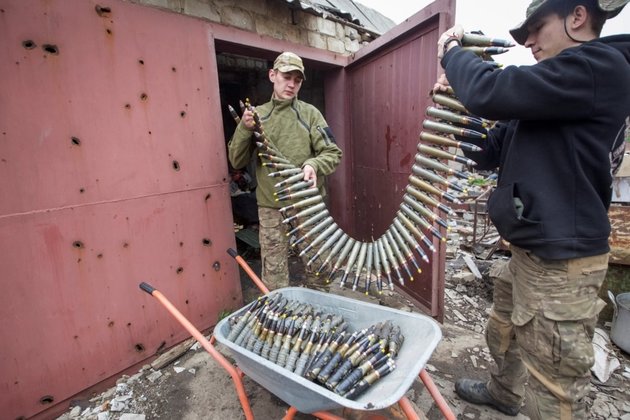

london – NATO’s most senior military official has warned that European ammunition stocks are running short as the West continues to send large amounts of military aid to Ukraine to fend off invading Russian forces.
Admiral Rob Bauer, who chairs the NATO Military Committee, said Europe needed to ramp up production as the war enters its 20th month.
‘We now give away weapons systems to Ukraine, which is great, and ammunition – but not from full warehouses. We started to give away from half full or lower warehouses in Europe. And therefore, the bottom of the barrel is now visible, and we need the industry to ramp up production in a much higher tempo. We need large volumes,’ Bauer told delegates Wednesday at the Warsaw Security Forum, adding that political leaders needed to act faster.
‘We need the continued support from the political level because it’s not only the money, it is also the actions in the nations that lead to more readier forces and the capabilities we need,’ Bauer said. ‘And if you actually see that in the seven years before the war, the [defense] budgets went up already, but the industry did not increase the production capacity. And that has led to higher prices already before the war.’
Forces fire thousands daily
Ukrainian forces are firing several thousand artillery shells every day at invading Russian forces, with much of the ammunition supplied by Kyiv’s Western allies. NATO member states also have given Kyiv tanks, armored vehicles, missile and air defense systems and an array of other military hardware.
The European Union, Britain and the United States have outlined plans to ramp up weapons production. The EU earlier this year allocated $2.2 billion for the joint procurement and delivery of up to an additional 1 million rounds of artillery ammunition to Ukraine by early 2024, and an additional $550 million to urgently boost EU defense industry capacities in ammunition production.
Simultaneously replenishing stockpiles – and supplying Ukraine – will require clearer signals from Western political leaders, said analyst Simona Soare of Britain’s Lancaster University, a former EU defense adviser.
‘Efforts from a budgetary point of view, from a procurement point of view, that allies have made individually and jointly, are still not on par with the level of the demand,’ Soare told VOA. ‘It all starts with that absolutely clear demand signal that comes from our political and military leadership towards our industry to engage in this effort jointly. And I believe that there is a lot more that can be done from that level to communicate that this effort is not a temporary surge, but rather it’s a sustained, potentially longer-term effort.’
Pentagon warns US leaders
In a letter to congressional leaders this week, the Pentagon warned it is running low on money to replace weapons the U.S. has sent to Ukraine.
According to The Associated Press, Pentagon comptroller Michael McCord told House and Senate leaders there is $1.6 billion left of the $25.9 billion Congress provided to replenish U.S. military stocks that have been flowing to Kyiv and urged them to replenish funding.
The United States has given an estimated $46.6 billion in military aid to Kyiv since Russia’s February 2022 invasion. The U.S. Congress passed a last-minute stopgap funding bill September 30 to avert a government shutdown, but it did not include any new aid for Ukraine. President Joe Biden has vowed to continue American support for Kyiv.
Meanwhile, the EU has given almost $27 billion, and Britain an estimated $7 billion in military aid, according to the Kiel Institute for the World Economy.
Boosting weapons production takes time, Soare said.
‘It takes on average between two and four years to set up a new production line for high-intensity military equipment that you need in Ukraine,’ Soare told VOA. ‘Same thing goes for munitions. We’re talking about hundreds, potentially thousands of people who need to have very, very niche skill sets to be employed in this undertaking.’
Soare added that Europe must diversify its supply chains for the crucial raw materials needed to produce modern weapons.
‘There are significant and long-standing dependencies on single providers for some of these absolutely critical rare earths, for instance, which now go at astronomical prices,’ she said. ‘And that impacts on the affordability side of the war effort.’
24World Media does not take any responsibility of the information you see on this page. The content this page contains is from independent third-party content provider. If you have any concerns regarding the content, please free to write us here: contact@24worldmedia.com

A Brief Look at the History of Telematics and Vehicles

Tips for Helping Your Students Learn More Efficiently

How To Diagnose Common Diesel Engine Problems Like a Pro

4 Common Myths About Wildland Firefighting Debunked

Is It Possible To Modernize Off-Grid Living?

4 Advantages of Owning Your Own Dump Truck

5 Characteristics of Truth and Consequences in NM

How To Make Your Wedding More Accessible

Ensure Large-Format Printing Success With These Tips

4 Reasons To Consider an Artificial Lawn

The Importance of Industrial Bearings in Manufacturing

5 Tips for Getting Your First Product Out the Door